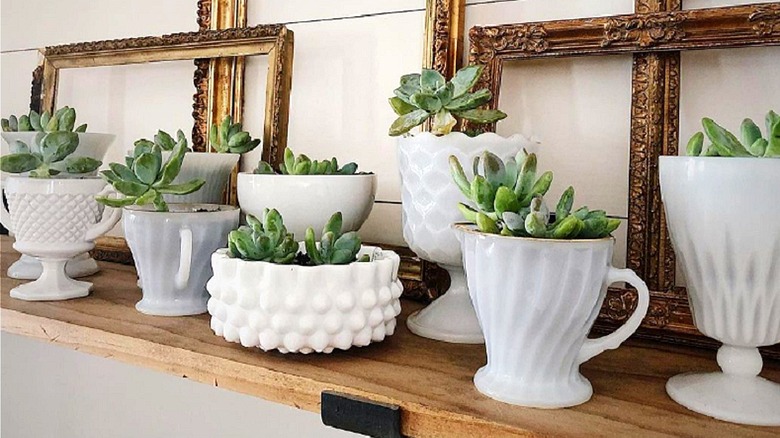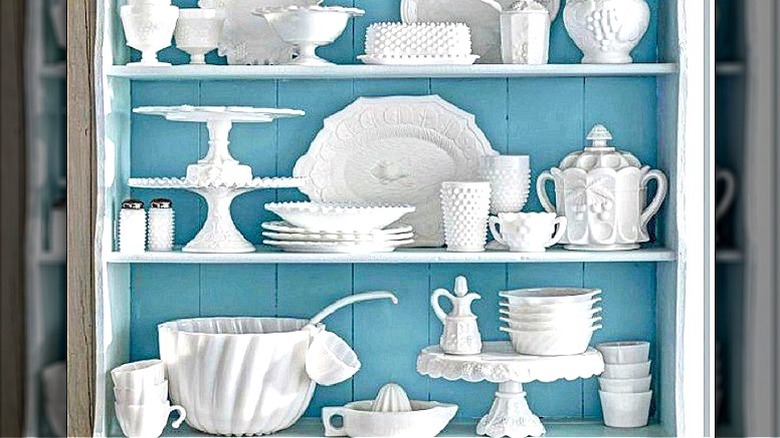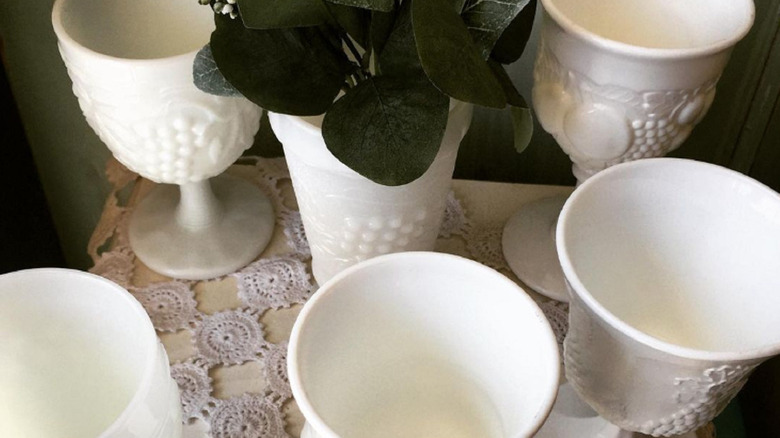The Vintage Glassware You Should Never Put In The Dishwasher
Vintage dishes aren't only beautiful additions to our kitchens and dining rooms; they also often offer insight into history, as well as serve as a great sustainable option for secondhand dinnerware. Milk glass, for example, is one of the most beautiful and collectible varieties of vintage glassware. If you happen to own milk glass in your home or are looking to start a collection, you likely have researched how best to care for the (primarily) white pieces, including how to wash them. For those who may wonder, you should never put milk glass in the dishwasher — lest you risk distorting its color.
Vintage milk glass, known for its dreamy white opaque or semi-translucent color, is a popular antique glassware to collect. A common 19th- and early 20th-century material, the glass was forged into everything from plates and bowls to pitchers, creamers, shakers, and larger serving pieces. Antique milk glass also can be found on lamps, candlesticks, vases, and other household objects. And while its durable glass isn't as fragile as some types of china, milk glass still doesn't fare particularly well in dishwashers. High heat and quickly changing temperatures can leave the glass looking dull and yellowed over time.
What is milk glass?
Dating back to the 16th century in Venice, milky, opaque glass, in a variety of colors (not just white), was initially pitched as a less expensive alternative to porcelain, which was often more delicate and had to be imported, usually from the Far East or other parts of Europe.
It was the Victorians, however, in the late 1800s who took a particular shine to this gorgeous glass, with several American and European companies manufacturing it in a number of formats and designs. Its popularity continued to rise and fall through the 20th century, spurred by companies like Westmoreland, Fenton, Hazel-Atlas, and Anchor-Hocking. Milk glassware enjoyed a particularly popular period post-WWII in midcentury households, which is why it's quite commonly found today in thrift shops, flea markets, and antique sellers.
The process of creating milk glassware depends on the addition of substances to the glass during its creation, including various chemical compounds, bone ash, and arsenic. The results would vary in opacity and finish, with some gaining an opalescent rainbow quality or semi-translucence. It's these compounds, particularly arsenic, that while safe to eat off of and use, can cause the glass to get a yellowish tinge when applied to high heat, such as the heat from a dishwasher. (Note, this also applies to the microwave.)
How to care for milk glass
Storage for your milk glassware collection is key. Ideally, you should keep it in a closed cabinet out of direct sunlight, as sun exposure can also cause yellowing. Since most milk glass is white, it'll show dust pretty readily as well, so dusting them with a cloth glove or small paintbrush will keep them looking good on display out in the open.
When using milk glass dishes, try to avoid foods known to stain, since the white isn't exactly forgiving to stains left by fruits and juices like berries. Also, since they respond to temperature change, it's best not to serve or use milk glass pieces for extraordinarily hot or cold materials, or to place them in the fridge or freezer.
To wash your milk glass items, as stated, avoid washing them in the dishwasher or otherwise applying extreme temperatures to the glass. It's advisable to avoid abrasive scrubbers as well. Instead, wash your milk glassware by hand using warm water and dish soap. Once clean, rinse and dry with a cloth.


